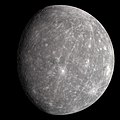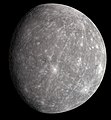File:Mercury in true color.jpg
外观

本预览的尺寸:600 × 600像素。 其他分辨率:240 × 240像素 | 480 × 480像素 | 768 × 768像素 | 1,040 × 1,040像素。
原始文件 (1,040 × 1,040像素,文件大小:408 KB,MIME类型:image/jpeg)
文件历史
点击某个日期/时间查看对应时刻的文件。
| 日期/时间 | 缩略图 | 大小 | 用户 | 备注 | |
|---|---|---|---|---|---|
| 当前 | 2023年5月15日 (一) 08:16 |  | 1,040 × 1,040(408 KB) | CactiStaccingCrane | Reverted to version as of 10:42, 24 July 2022 (UTC) |
| 2023年5月15日 (一) 08:01 |  | 1,024 × 1,024(837 KB) | CactiStaccingCrane | Manually merge the original monochrome image with the calibrated color image to eek out more resolution | |
| 2022年7月24日 (日) 10:42 |  | 1,040 × 1,040(408 KB) | JCP-JohnCarlo | Make this planet image center | |
| 2022年7月24日 (日) 10:25 |  | 1,040 × 1,040(710 KB) | JCP-JohnCarlo | Canvas image | |
| 2019年11月3日 (日) 09:00 |  | 960 × 1,040(865 KB) | Mirecki | User created page with UploadWizard |
文件用途
以下3个页面使用本文件:
全域文件用途
以下其他wiki使用此文件:
- af.wikipedia.org上的用途
- als.wikipedia.org上的用途
- ar.wikibooks.org上的用途
- as.wikipedia.org上的用途
- be-tarask.wikipedia.org上的用途
- beta.wikiversity.org上的用途
- bn.wikipedia.org上的用途
- bn.wikibooks.org上的用途
- bo.wikipedia.org上的用途
- br.wikipedia.org上的用途
- ca.wikipedia.org上的用途
- ceb.wikipedia.org上的用途
- ckb.wiktionary.org上的用途
- csb.wikipedia.org上的用途
- cs.wikiversity.org上的用途
- cv.wikipedia.org上的用途
- cy.wikipedia.org上的用途
- de.wikipedia.org上的用途
- de.wiktionary.org上的用途
- dty.wikipedia.org上的用途
- dz.wikipedia.org上的用途
- eml.wikipedia.org上的用途
- en.wikipedia.org上的用途
- Mercury (planet)
- Terrestrial planet
- The Planets
- Timeline of discovery of Solar System planets and their moons
- List of Solar System objects by size
- List of gravitationally rounded objects of the Solar System
- User:Kwamikagami/sandbox
- NASA
- User:Kazkaskazkasako/Books/Physical sciences
- Talk:Mercury (planet)/Archive 3
- User:Nrco0e/Userboxes
- User:Applekle/sandbox
- Wikipedia:Userboxes/Location/Extraterrestrial
- Talk:The Planets/GA1
- User:Double sharp/Largest Solar System objects
- User:TomMasterReal
- User:Nrco0e/Userboxes/FavMercury
查看此文件的更多全域用途。



